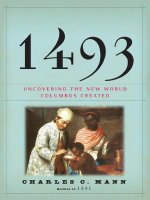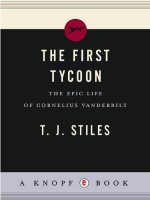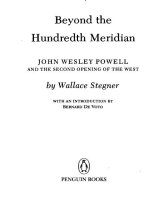G j meyer the tudors the complete story sty (v5 0)
Bạn đang xem bản rút gọn của tài liệu. Xem và tải ngay bản đầy đủ của tài liệu tại đây (2.71 MB, 458 trang )
Also by G. J. Meyer
A World Undone: The Story of the Great War, 1914–1918
For Rosie
Contents
Map
Family Tree
A Tudor Timeline
Introduction
Prologue: August 22, 1485
The Battle of Bosworth: An exile returns.
PART ONE
An Excess of Good Fortune: 1485–1532
1: The Luck of Henry Tudor
The king who had (almost) everything.
Background: The Origin of the Tudors
2: The King’s Great Matter
His pursuit of an annulment—and of Anne Boleyn.
Background: The Spanish Connection
3: Frustration and Embarrassment
Queen Catherine resists, and finds support.
Background: England Then
4: Radical Departures
Moving the line between church and state.
Background: The Old Church
5: Another Way Devised
A policy of winning by intimidation—and terror.
Background: The Royal Horn of Plenty
6: A Revolution in the Making
Henry raises the stakes.
Background: Windows of Opportunity
7: A Thunderbolt Falls
The royal ultimatum.
Background: Parliament
8: Submission
The archbishop of Canterbury surrenders.
Background: Other Reformations
9: Consummation
The king beds, then weds, Anne Boleyn.
PART TWO
Monster: 1533–1547
10: First Blood
The destruction of the Nun of Kent.
Background: The Tower
11: Supremacy
Parliament acknowledges the king’s new powers.
Background: Monks, Nuns, and Friars
12: “We Will All Die”
Destruction of the Charterhouse monks, and of John Fisher.
Background: Best Sellers
13: “Preserve My Friends from Such Favors”
Trial and execution of Thomas More; the monastic visits.
Background: Popes
14: All but Godlike
Anne Boleyn is replaced; the smaller monasteries destroyed.
Background: They Were What They Ate
15: Rebellion and Betrayal
Explosion: the Pilgrimage of Grace; King Henry gets his son.
Background: The Sport of Kings
16: The Last of Henry
Three more wives, money trouble, a final torrent of killings.
PART THREE
A King Too Soon and a Queen Too Late: 1547–1558
17: A New Beginning
Evangelicals triumph; Edward Seymour assumes command.
Background: Instruments of Power
18: England’s Second Reformation
Henry VIII’s church dismantled; the fall of Seymour.
Background: Calvin
19: A Revolution and a Coup
The rise of John Dudley, the death of Edward VI, the brief reign of Jane Grey.
Background: The Making of Mary
20: Another New Beginning
Mary I and the restoration of the old religion.
Background: Schooling and the Schools
21: And Another Early End
Dreams turn to dust.
PART FOUR
Survivor: 1558–1603
22: Yet Another New Beginning
The return to Protestantism.
Background: The Council of Trent
23: The Succession, Again
Robert Dudley and the hope for an heir.
Background: The Fall and Rise of English Theater
24: A Torrent of Miseries
Religion, the succession, and Mary, Queen of Scots.
Background: The Turks
25: Actions, Reactions, Provocations
Trouble in France, trouble with Spain; rebellion in the Netherlands.
Background: Torture
26: A Horrific Tangle—And War at Last
Years of meddling produce war in the Netherlands.
Background: The Punishment of the Innocent
27: The Last Favorite
The Rise of Robert Devereux, Earl of Essex.
Background: Winning Big
28: A Seat at the Table
The rivalry of Essex and Robert Cecil.
Background: A Diamond of England
29: The Last Act
The fall of Essex; the dismal final decade of the Tudor Age.
An Epilogue in Two Parts
Sources and Notes
A Tudor Timeline
1457
January 28
1485
August 22
Henry Tudor is born to Lady Margaret Beaufort, thirteenyear-old widow of Edmund Tudor, Earl of Richmond
Tudor is crowned Henry VII of England after defeating
Richard III in the Battle of Bosworth Field
December 15
Catherine of Aragon is born in Spain
January 18
Marriage of Henry VII to Elizabeth of York
September 19
Birth of Arthur, Prince of Wales
1491
June 28
Birth of future King Henry VIII
1494
September 12
Birth of future King Francis I of France
1495
April 27
Birth of Suleiman I, Sultan of the Ottoman Empire
1500
February 24
Birth of Charles of Hapsburg, future Emperor Charles V
1501
November 14
Catherine of Aragon is married to Arthur, Prince of Wales
1502
April 2
Death of Arthur, Prince of Wales
1503
February 11
Death of Elizabeth of York, Henry VIII’s mother
1509
April 22
Death of Henry VII
June 11
Henry VIII is married to Catherine of Aragon
1486
1513
June 30
September 9
Henry crosses the Channel to take command of the campaign
against France
Scots army is destroyed by the Earl of Surrey’s English force
at the Battle of Flodden
1515
December 24
Thomas Wolsey becomes chancellor of England
1516
February 18
Future Queen Mary I is born to Catherine of Aragon
1519
June 15
Birth of Henry VIII’s illegitimate son Henry Fitzroy
1527
May 21
Birth of Philip of Hapsburg, future King of Spain and
husband of Mary I
1529
September 22
Thomas Wolsey is stripped of chancellorship, replaced by
1532
March 30
Thomas Cranmer is consecrated as archbishop of Canterbury
May 16
More is allowed to resign after the submission of the clergy
January 25
Henry VIII is quietly married to Anne Boleyn
April 13
Anne is proclaimed queen
1533
May 28
1534
September 7
Birth of future Queen Elizabeth I
April 20
Execution of Elizabeth Barton, “Nun of Kent”
Thomas Cromwell is confirmed as Henry VIII’s principal
secretary
The Act of Supremacy establishes Henry VIII as head of the
church in England
June 22
Execution of John Fisher
July 6
Execution of Thomas More
January 7
Death of Catherine of Aragon
March
Dissolution of monasteries begins
May 19
Execution of Anne Boleyn
May 30
Marriage of Henry VIII to Jane Seymour
July 1
Mary and Elizabeth are declared illegitimate
July
Ten Articles assert reformist religious doctrines
July 22
1537
valid
Parliament extinguishes papal authority in England
November
1536
Cranmer’s court declares Henry’s marriage to Anne to be
June 8
April
1535
Thomas More
Death of Henry VIII’s illegitimate son Henry Fitzroy, Duke of
Richmond
October 8
Start of Pilgrimage of Grace in Yorkshire
October 12
Birth of future King Edward VI
October 24
Death of Jane Seymour
1539
June
Act of Six Articles returns the church to a more conservative
1540
January 6
position
Henry VIII is married to Anne of Cleves
1540
July 9
Cleves marriage is dissolved
July 28
Henry VIII is married to Catherine Howard; Thomas
Cromwell is executed the same day
1541
May 27
Execution of Margaret Pole, Countess of Salisbury
1542
February 13
Execution of Catherine Howard
December 8
Birth of Mary Stuart, future Queen of Scots
December 13
Death of James V of Scotland
1543
July 12
Marriage of Henry VIII to Catherine Parr
1544
July 14
Henry crosses the Channel to make war on France
1547
January 28
Death of Henry VIII
February 20
Coronation of Edward VI
March 31
Death of Francis I of France
At the Battle of Pinkie English forces commanded by Edward
September 10
Seymour, new lord protector and Duke of Somerset, defeat
the Scots
1549
July 8
Start of Kett’s Rebellion in Norfolk
September 5
Execution of Thomas Seymour
Arrest of Edward Seymour, Duke of Somerset; John Dudley,
1551
October 11
new lord president of Edward VI’s council, is elevated to
Duke of Northumberland
1552
January 22
Execution of Somerset
1553
May 21
Marriage of Lady Jane Grey to Guildford Dudley
July 6
Death of Edward VI
July 10
Jane Grey is proclaimed queen
August 3
Mary I enters London in triumph two weeks after being
proclaimed queen
1554
August 21
Execution of John Dudley, Duke of Northumberland
October 30
Coronation of Mary I
February 12
Execution of Jane Grey and Guildford Dudley
April 11
Execution of Sir Thomas Wyatt
May 19
1555
Tower
July 25
Marriage of Mary I to Philip II of Spain
October 16
Execution of Nicholas Ridley and Hugh Latimer
November 12
Death of Stephen Gardiner, chancellor
1556
March 21
1558
January 5
April 24
November 17
1559
Release of Elizabeth after two months of confinement in the
Execution of Thomas Cranmer; Reginald Pole becomes
archbishop of Canterbury
Fall of Calais to France
Marriage of Mary Queen of Scots to future Francis II of
France
Deaths of Mary I and Reginald Pole; appointment of William
Cecil as Queen Elizabeth’s secretary of state
January 15
Coronation of Elizabeth I
May 8
Elizabeth signs Act of Uniformity
September 18
Mary Queen of Scots becomes Queen of France with
accession of Francis II
1560
December 5
Death of Francis II
1561
August 19
Arrival of Mary Queen of Scots in Scotland
1564
September 29
Robert Dudley is created Earl of Leicester
1565
July 29
Mary Queen of Scots weds Henry Stuart, Lord Darnley
1566
June 19
Birth of future James VI of Scotland and James I of England
1567
February 10
Murder of Darnley
May 15
Mary Queen of Scots is married to James Hepburn, Earl of
Bothwell
1571
July
24 25
February
With
Mary
a prisoner,
son is proclaimed
King James VI
William
Cecil
is raised her
to nobility
as Baron Burghley
1572
June 2
Execution of Thomas Howard, fourth Duke of Norfolk
August 24
Start of St. Bartholomew’s Massacre in Paris
June 9
Death of Francis, Duke of Alençon
July 10
Assassination of William of Orange
1584
With Treaty of Nonsuch, England commits to sending troops
1585
August 20
1586
January 15
1587
February 8
Execution of Mary, Queen of Scots
1588
July 27
Spanish Armada arrives off Calais
September 4
Death of Robert Dudley, Earl of Leicester
to the Netherlands
Earl of Leicester takes the oath as governor-general of the
Netherlands
Robert Devereux, Earl of Essex, becomes a member of the
1593
February 25
1596
July 5
Robert Cecil is appointed secretary of state
1598
August 4
Death of William Cecil, Lord Burghley
September 13
Death of Philip II
1599
April 14
Earl of Essex arrives in Ireland as lord lieutenant
1600
June 5
Arrest of Essex
1601
February 25
Execution of Essex
1603
March 24
Death of Elizabeth I
Privy Council
Introduction
T
he Tudors ruled England for only three generations, an almost pathetically brief
span of time in comparison with other dynasties before and since. During the 118
years of Tudor rule, England was a less weighty factor in European politics than it had
been earlier, and nothing like the world power it would later become. Of the ve Tudors
who occupied the throne—three kings, followed by the rst two women ever to be
queens of England by right of inheritance rather than marriage—one was an epically
tragic gure in the fullest Aristotelian sense, two reigned only brie y and came to
miserable ends, and the last and longest-lived devoted her life and her reign and the
resources of her kingdom to no loftier objective than her own survival. Theirs was, by
most measures, a melancholy story. It is impossible not to suspect that even the founder
of the dynasty, the only Tudor whose reign was both long and mostly peaceful and did
not divide the people of England against themselves (all of which helps to explain why
he is forgotten today), would have been appalled to see where his descendants took his
kingdom and how their story ended.
And yet, more than four centuries after the Tudors became extinct, one of them is the
most famous king and another the most famous queen in the history not only of England
but of Europe and probably the world. They have become not merely famous but
posthumous stars in the twenty- rst-century rmament of celebrity: on the big and little
screens and in popular ction their names have become synonymous with greatness,
with glory. This is not the fate one might have expected for a pair whose characters were
dominated by cold and ruthless egotism, whose careers were studded with acts of
atrocious cruelty and false dealing, and who were never more than stonily indi erent to
the well-being of the people they ruled. It takes some explaining.
At least as remarkable as the endlessly growing celebrity of the Tudors is the extent to
which, after so many centuries, they remain controversial among scholars. Here, too,
the reasons are many and complex. They begin with the fact that the dynasty’s pivotal
gure, Henry VIII, really did change history to an extent rivaled by few other monarchs,
and that appraisals of his reign were long entangled in questions of religious belief. It
matters also that both Henry and his daughter Elizabeth were not just rulers but
consummate performers, masters of political propaganda and political theater. They
created, and spent their lives hiding inside, ctional versions of themselves that never
bore more than a severely limited relation to reality but were nevertheless successfully
imprinted on the collective imagination of their own time. These invented personas
have endured into the modern world not only because of their inherent appeal—it is
hard to resist the image of blu King Hal, of Gloriana the Virgin Queen—but even more
because of their political usefulness across the generations.
Henry, in the process of forcing upon England a revolution-from-above that few of its
people welcomed, created a new elite that his radical redistribution of the national
wealth made so rich and powerful so quickly that within a few generations it would
prove capable of overthrowing the Crown itself. No longer needing or willing to tolerate
a monarchy as overbearing as the Tudors had been at their zenith, that new elite
nevertheless continued to need the idea of the Tudors, of the wonders of the Tudor
revolution, in order to justify its own privileged position. It needed to make the mass of
English men and women see the Tudor century as the supreme forward leap in
England’s history, a sweeping away of the dark legacy of the Middle Ages. (This whole
“Whig” view of history requires a smug certainty that the medieval world was a cesspit
of superstition and repression.) It demanded agreement that the Tudors had put England
on the high road to greatness, and that to say otherwise was to be not only
extravagantly foolish or dishonest but actually un t for participation in public life.
Centuries of relentless indoctrination and denial ensued, with the result that England
turned into a rather curious phenomenon: a great nation actively contemptuous of much
of its own history. One still sees the evidence almost whenever British television
attempts to deal with pre-Tudor and Tudor history.
It was not until the second half of the twentieth century, really, that historians of
some eminence in England and the United States began, often slowly and grudgingly, to
acknowledge that the established view of the Tudor era was essentially mythological
and could never be reconciled with a dispassionate examination of the facts. Not until
even more recently was the old propaganda pretty much abandoned as indefensible.
Tudor history remains controversial because, quite extraordinarily for a subject now half
a millennium old, its meaning is still being settled. The truth is still being cleared of
centuries of systematic denial.
With the academy still bringing sixteenth-century England into focus, we should not
be surprised that much of the reading public and virtually the entire entertainment
industry remain in the thrall of Tudors who never existed. Whether this will ever change
—whether the cartoon versions of Henry VIII and Elizabeth I that now shine in the
celebrity heavens alongside James Dean and the Incredible Hulk will ever give way to
something with a better connection to reality—is anybody’s guess. Perhaps such a
change is no longer possible. It is certainly not going to happen as a consequence of this
book. I do entertain the more modest hope, however, that a single volume aimed at
introducing the entire dynasty to a general readership might prove useful in two ways:
by helping to show that the true story of the Tudors is much richer and more fascinating
than the fantasy version, and by showing also that the whole story is vastly greater than
the sum of its parts. That it contains depths and dimensions that cannot be brought to
light by focusing exclusively on Henry VIII, Elizabeth I, or any other single member of
the family. That if it is as deeply tragic as I believe it to be—as I hope I have shown it to
be—the extent of the tragedy can become clear only when the ve reigns are joined
together in a narrative arc that begins with Henry VII building a great legacy out of
almost nothing, moves on to his son’s extravagant abuse of a magni cent inheritance,
and follows the son’s three children as, one after another and in their joltingly di erent
ways, they attempt to cope with what their father had wrought. If a writer should have
an excuse for adding to the endless stream of Tudor literature, I therefore o er these:
that not enough has been done to deal with the Tudor dynasty as a continuum, a unity,
a n d that popular perceptions of the family have fallen so far behind scholarly
understanding that it is necessary to try, at least, to narrow the gap.
I disavow any claim to competing with, never mind replacing, the many splendid
biographies of the Tudor monarchs and their spouses, agents, and victims that have
appeared over the last half-century or so. To the contrary, I have drawn heavily on
many such works in assembling the facts with which to weave my story, and I am not
merely in their debt but could scarcely have even begun without them. And I am mindful
that my approach carries a price: dealing with ve reigns obviously makes it impossible
to provide the depth of detail available in (to cite just one distinguished example) J. J.
Scarisbrick’s magisterial Henry VIII. But it seems fair to question whether so much detail
is necessary or even desirable in a work aimed at a general readership, and in any case
forgoing it brings a gain too. The story of the whole dynasty is not only bigger in
obvious ways than any biography—encompassing more personalities, more drama,
more astoundingly grand and ugly events—but also, if paradoxically, deeper in one notinsigni cant sense. The story of any one Tudor becomes fully rounded only when set in
the context of what had come before and what followed, with causes and e ects
sketched in.
Not being a work of scholarship in anything like a strict and academic sense—not the
fruit of deep tunneling into original source materials—this book is not intended for
professional Tudor scholars. I can only express my gratitude to the members of that
community, most of whom will be familiar with my facts and my arguments and some
of whom (any still attached to the old conception of the Tudors as “builders of England’s
glory,” certainly) are likely to reject my conclusions. In any case those conclusions,
based on years of reading and re ection, are my responsibility entirely and not to be
blamed on anyone else.
I am indebted to my editor, John Flicker, whose suggestions unfailingly prove to be
perceptive and helpful (even and perhaps especially the ones I don’t welcome at rst),
to my agent, Judith Riven, for her un agging support and encouragement, and above
all to my partner, Sandra Rose, who cheerfully shared and endured the whole yearslong, life-devouring process.
G. J. Meyer
Goring-on-Thames, England
June 2009
Prologue
August 22, 1485
I
t is an astonishing fact, and a measure of how much the world has changed in ve
hundred years, that of the thousands of men who were present at what would come
to be called the Battle of Bosworth Field, not one left us a description of it. By any
reckoning it was one of the great events of English history—even a glorious event,
assuming that your idea of glory is broad enough to embrace the ring of arrows into
the bodies of living men and the breaking open of their skulls with axes. It was the
blazing sundown of the Middle Ages: men in armor, gleaming blades, banners waving in
the summer breeze. It would bring the last charge by mounted knights ever seen on
English soil, the last death of a king of England in battle.
But because we have no eyewitness accounts, nor even any accounts written while
memories of the battle were still fresh, we know far less about it than historians have
traditionally pretended.
We know of course that King Richard III was on the scene—a tough little man with
reddish-gold hair, only ve foot four but a seasoned warrior, awesomely courageous, the
hardened veteran of many bloody ghts. We know with certainty that he was there,
because he was within minutes of his famously nasty death. We can be sure that he wore
a sword, the familiar tool of his trade, and that he carried it as easily as a carpenter
carries his hammer. His armor would have been covered with a tunic, made of silk,
probably, bearing the colorful symbols of his Plantagenet ancestry. We are told that his
horse was white. Being the king’s, no doubt it was a majestic horse; feel free to picture it
snorting and prancing. That Richard wore a lightweight crown, a coronet, over his iron
helmet also is plausible, as his purpose that day was to defend his possession of the
crown. With him was his standard-bearer, his old comrade-in-arms Sir Percival Thirlwall,
holding aloft a sta from which streamed a long standard displaying Richard’s emblem,
the blue boar.
And of course Henry Tudor was there—a good distance from Richard, necessarily, but
not quite so far away as to be out of sight. As it happens, he too was astride a white
horse, one he had been given at some point in the previous two weeks as he and his
ragged little army of French and Breton mercenaries and English runaways made their
long trek across Wales. No doubt people would have been surprised to learn that, at
twenty-seven, Henry was only four years younger than Richard; he was so unknown,
had so much less experience and apparent substance, as to seem a boy by comparison.
So far as we know, he had never been in a ght of any kind. He had never commanded
soldiers or ruled anything. Until that month he had not set foot in Wales in almost
fourteen years, and the time he had spent in England could be measured in days.
Richard could trace his descent in the male line back through three hundred years of
royalty—he was a shoot of the same family tree that had produced Richard the LionHearted and any number of other legendary heroes. Beyond that his ancestry reached to
William I’s granddaughter and so nally to the Conqueror himself. By contrast, Henry
Tudor was the grandson of a Welsh commoner who had had his head chopped o in a
town square, and this at a time when most Englishmen regarded the Welsh as a scarily
alien race. And yet here he was, presuming to call himself the Earl of Richmond, come
to the gentle green hills of the English Midlands for the declared purpose of making
himself king.
That he might ever be able to launch even a semicredible e ort to take the throne
would have seemed impossible just thirty months before. Until 1483 he had been living
an idle, pointless life at the court of Duke Francis of Brittany, whose guest and political
pawn he had been for nearly half his life. He had been adopted, by then, as the focus if
not necessarily the real leader of England’s Lancastrian faction—as the man who would
be king if somehow the House of York could be overthrown, though increasingly that
seemed an empty honor. The leader of the Yorkists, Edward IV, was a strong king in
secure possession of the throne, the picture of boisterous good health at age forty, if soft
and overweight after almost a decade and a half of peace. He also had a large brood of
daughters and sons, the eldest of them just entering adulthood. There was every reason
to expect that he and his descendants would rule for generations—and that there would
be no place in England for the likes of Henry Tudor.
But then in March 1483 King Edward su ered something like a stroke and within a
few weeks was dead. His heir, another Edward, was only twelve and therefore not
possibly ready to rule, but that should not have been a problem because the boy had
uncles—men of proven loyalty and talent—to govern on his behalf and guide him to
maturity. On the paternal side was the dead king’s youngest and last surviving brother,
Richard, Duke of Gloucester, still barely thirty but deeply experienced in the arts of war
and governance. Opposite him was Anthony Woodville, Earl Rivers, eldest of the
numerous ambitious brothers of Edward IV’s widow, Queen Elizabeth. There was a
problem, however: bad blood between Richard (who was supported by many of the old
noble families) and the upstart Woodvilles, who were resented bitterly because of the
wealth and power that had come to them for no better reason than the fact that King
Edward, while still a very young man, had impulsively married the obscure if powerfully
attractive widow Elizabeth Woodville Grey.
Duke Richard, it is clear, saw the situation as fraught with danger for himself. Earl
Rivers had a close relationship with their nephew, whereas Richard, who for years had
been far from court governing the north as his brother’s representative, scarcely knew
the boy. The duke need not have been paranoid to fear that if the Woodvilles could
maintain custody of young Edward V—hardly an improbable development, considering
that the child’s mother was the most prominent Woodville of them all—they could also
control the government and destroy their rivals. Whatever his motives, whether he was
driven by ambition, hatred, or fear, Richard struck rst, setting in motion a series of
atrocities that would not end until eight of the last ten legitimate Plantagenet males,
ve of them boys too young to marry, had died violently. He came down from the north
and ordered Rivers to bring their nephew to him. When Rivers did so, both he and the
boy were taken into custody. In short order Rivers was executed along with young
Richard Grey, Queen Elizabeth’s son by her rst marriage. Edward V and his ten-yearold brother were sent to the Tower, and Duke Richard had himself crowned.
Convulsion followed convulsion, and with each new upheaval the existence of Henry
Tudor became both more signi cant and more precarious. The princes in the Tower
were heard of no more—it was impossible to doubt that they had been murdered—and
many of the men who had gured importantly in Edward IV’s regime left England
rather than support the new King Richard III. Ineptly and for reasons that remain
obscure, the Duke of Buckingham, probably the richest noble in England and a man
whose royal blood gave him a claim to the throne, raised a rebellion not in his own
name but in Henry Tudor’s. Francis of Brittany gave Henry a tiny eet and army with
which to invade England, but it was scattered by storms. By the time the ship carrying
Henry hauled alone into Plymouth harbor, Buckingham had been defeated and executed
and the rebellion was over. Richard’s agents met an advance party sent ashore by Henry
and, by reporting that the rebellion had already succeeded, tried to lure him ashore. He
learned the truth in time, however, and made his escape. Fresh storms then drove him
into port in France, and with great di culty he managed to make his way overland
back to Brittany. When on Christmas Day the English exiles who had gathered in
Brittany assembled at Rennes Cathedral and pledged to support Henry, their oaths must
have seemed nearly meaningless. Equally empty was Henry’s promise, made that same
day, to marry Edward IV’s eldest daughter, Elizabeth of York, then in sanctuary at
Westminster Abbey with her mother and four sisters.
Worse soon followed. An exiled bishop with sources of information at the English
court sent word that the Duke of Brittany was negotiating an agreement by which he
would be richly rewarded for delivering Henry to King Richard. Henry opened
communications with the French court and, upon establishing that he would be welcome
there, laid plans to get himself and his followers across the Breton-French border. This
ended in high drama: Duke Francis’s soldiers were hard on Henry’s heels as he galloped
to France and safety. From that point, however, all his luck was good. The French king,
Charles VIII, was a boy in early adolescence. His older sister, Anne of Beaujeu, headed
the government as regent and badly needed to make trouble for Richard III, who was
attempting to encircle France by allying himself with the two autonomous duchies of
Brittany and Burgundy. (It is worth noting, in this connection, that Charles and Anne
would have regarded young Tudor not only as a useful political tool but as a near
kinsman. Henry’s grandmother Catherine of Valois had been their grandfather’s sister.)
They added to the money coming to Henry from England to provide him with the means
to again assemble some ships and hire a mercenary army. The resulting invasion force
sailed out of Hon eur in Normandy on August 1, had good weather all the way this
time, and made landfall at Milford Haven in the southwestern corner of Wales just six
days later. It is said that Henry had to set one of his ships a re to prevent some of his
more fainthearted troops from returning to France.
Richard, meanwhile, was experiencing much misery. His son and heir had died early
in his reign, and when his wife died not long afterward, it was widely rumored that he
had had her poisoned in order to free himself to marry his niece Elizabeth of York. The
rumors became so damaging that he was obliged to take the humiliating step of denying
them publicly. His subjects, evidently, were prepared to believe anything of him so long
as it was su ciently horri c. He made e orts to shore up his base of support—raising
John Howard to Duke of Norfolk, for example, and giving o ces and lands to the
Stanley family—but the estimated number of his troops, when they came face-to-face
with Henry Tudor’s on August 22, suggests that he should have done more along that
line, done it sooner, and been more careful in selecting the beneficiaries.
We don’t know the size of the armies that faced each other that day. Henry must have
had about ve thousand men: several hundred displaced Englishmen who had made him
the centerpiece of their quest for revenge, a few thousand thuggish soldiers-for-hire
contributed by the regent of France, and a disappointingly small number—no more than
a thousand or two, surely—who had joined him after he came ashore in southwestern
Wales. Richard may have had twelve thousand, possibly ten, possibly fewer than that;
the estimates vary, and there is no way of choosing among them. Whatever Richard’s
total, it would have been cause for concern. It was pathetic compared to the thirty- ve
thousand or more troops that his late brother Edward IV had taken into the Battle of
Towton on Palm Sunday in 1461, or the army of fty thousand Lancastrians that
Edward’s men had shattered that day. Richard had known months in advance that an
invasion was being prepared. He had learned on August 11 that the invaders had landed
four days earlier, and he had sent out summonses for the nobles of England and Wales,
all of whom had been put on alert weeks before, to muster their soldiery and join him at
Leicester. No more than one in every ve had done so. It was unsettling evidence of
how little support Richard had, and of how badly the old feudal system had decayed.
Strangely, ominously, there was a third army on the field; it might even be accurate to
say that there were four. These were the forces of the Stanley clan, raised to the nobility
less than twenty years before but already a major power, the greatest landowners in the
northwest and de facto rulers of the Isle of Man. The Stanleys had remained loyal to
Richard in 1483, when he seized the throne after his brother’s sudden death and the
Duke of Buckingham raised a rebellion against him, and they had been richly rewarded
for doing so. The head of the clan, Thomas Lord Stanley, had been made constable of
England and steward of the royal household. His brother Sir William was chamberlain—
governor, in e ect—of Chester and North Wales. Upon receiving word that Henry Tudor
was ashore, Richard had ordered the Stanleys to join him with their liegemen. They had
done so, but more slowly than Richard could have wished, and their behavior had
become increasingly suspect. Much earlier than Richard himself, they were in a position
to intercept the invaders as they emerged from Wales. Instead of doing so they had
continually fallen back, allowing the advance to continue. Now, with the showdown
clearly at hand, they had some five thousand men with them, separated into two groups,
each commanded by one of the brothers. Nobody knew whose side they were on;
apparently they were pretending to be on both sides while not yet knowing themselves
what they were going to do. Their rst loyalty had always been to themselves, and they
had long ago demonstrated that they would betray even kings when doing so was more
or less certain to be to their advantage. Richard, aware of their history and fearful of
their power, was holding Lord Stanley’s son hostage. It is said that he threatened to
have the son executed if the Stanleys failed to join their forces with his, and was told by
way of response that his lordship had other sons. It is said also that when Henry Tudor
asked Stanley to join him on the morning of August 22, he was told to mind his own
business.
One of the more bizarre aspects of this story is that Stanley was Henry Tudor’s
stepfather, the third husband (or fourth, if one counts a childhood marriage that ended
in annulment) of his mother, Margaret Beaufort. It was a purely political marriage—the
contract stipulated that the bride’s chastity was not to be compromised. Though it is
almost certain that Henry had long been in secret communication with the Stanleys and
was counting on their support, he could not have been con dent of getting it. The
brothers were hanging back, Sir William with his men in one place and Lord Thomas
with his in another, watching the situation unfold. If they could be counted upon to do
anything, it was to wait until someone was winning and then strike at the loser in order
to be in on the spoils.
The detailed descriptions in countless books notwithstanding, we have no way of
knowing how the various forces were arranged. We don’t even know where they were,
except somewhere within a circle with a diameter of several miles. When the earliest
account nally was written, presumably drawing on the testimony of participants, its
author was an Italian retainer at the English court who had good reason to want to
please his Tudor masters. He tells wonderful stories: That Richard was uneasy all
through the night before the battle, and that the little sleep he managed to get was
punctuated with horrible dreams. That he rose while it was still dark (which means that
he must have been up by four A.M.), inspected his lines, and ran his sword through a
sentry who was sleeping on duty. That he wanted to hear mass, but the only available
priest was unable to nd the necessities. That when he called for breakfast, it too
proved to be impossible. And that the most powerful and dependable of his henchmen,
long-faced old John Howard, Duke of Norfolk, awoke to nd a handwritten verse
fastened to the entrance of the house where he had slept:
Jack of Norfolk, be not too bold,
For Dickon, thy master, is bought and sold.
“Dickon” would be Richard. For “bought and sold” we would today say “sold out.” We
are told that Richard’s army was melting away like snow in springtime, some of the
deserters joining the rebels, others running for home.
These stories have come down to us at second or third hand, selected by a writer who
was a propagandist at least as much as a historian, and any or all of them could be
inventions. We can’t even be certain that the Battle of Bosworth Field was fought at the
place called Bosworth Field, which is now a popular attraction with walking tours and a
visitor center and all the paraphernalia of the tourist trade. Richard is supposed to have
positioned his forces there, atop a high point called Ambien Hill, from which he could
look out and see his enemies approaching in the distance. Henry Tudor would have been
accompanied by his standard-bearer William Brandon, who hoisted a banner on which
was displayed the red dragon of Wales. They would have been surrounded by a
lifeguard of pike-wielding foot soldiers and mounted knights.
Supposedly the battle began when the main body of Tudor troops, commanded by the
dashing Earl of Oxford, recently escaped after ten years as Richard’s prisoner, started up
Ambien Hill. Perhaps it happened that way, but students of the battle now living claim
that the two sides collided not at Ambien Hill but on atter ground some distance away.
The evidence they o er is complicated but not easily dismissed. The author of the
present work can attest, after visiting Bosworth and walking its length and breadth, that
the landscape as it exists today does not make the traditional version of the story
particularly convincing.
This we do know: at some point after the rst clash of troops under the command of
Oxford on one side and Norfolk on the other, with the situation stalemated and the
Stanleys still hovering like vultures on the sidelines, Richard made a decision that would
lead to one of the most dramatic climaxes in the history of warfare. He decided to forget
about defeating the invader army with his army and instead settle things personally, in
something very close to single combat, himself against Henry Tudor. In the absence of
sources, it is permissible to imagine him summoning his lifeguard of perhaps a hundred
knights to gather round, unsheathing his sword and pointing with it in the direction of
the red dragon, and shouting for his men to follow while spurring his charger into a
headlong gallop. Something like that has to have happened.
Why it happened we can never know. Possibly Richard acted out of desperation:
apparently Norfolk had been killed by this point (taken by an arrow in the throat by
one account, executed on the spot after surrendering to Oxford by another), and if
indeed his troops had failed in an initial assault despite their superior numbers, this
must have been deeply unsettling. Or perhaps Richard saw a target that was simply too
tempting to ignore: the tiny far-o
gure of Henry Tudor, as passive as the king in a
game of chess, remote from the action and not that strongly protected. If Henry’s guard
could be penetrated—and why not, if Richard himself brought a phalanx of heavy
cavalry down on it like the blow of a mace—killing him would become a simple matter.
It would no longer matter what the Stanleys or anyone else did. The Tudor cause would
be decapitated, the whole invasion rendered pointless.
What ensued was a poetically tting end to three centuries of rule by Plantagenet
warrior-kings. The last link in that long royal chain, sword in hand and blue boar
unfurled above his head, thundered across the battle eld with his knights just behind,









